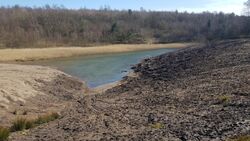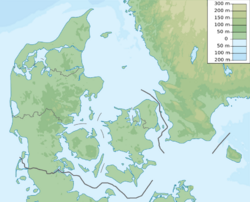Gram Formation
Topic: Earth
 From HandWiki - Reading time: 2 min
From HandWiki - Reading time: 2 min
Short description: Geologic formation in Gram, Denmark
| Gram Formation Stratigraphic range: Tortonian ~11.6–7.2 Ma | |
|---|---|
 Gram Clay Pit, the prime source of fossils from the Gram Formation | |
| Type | Formation |
| Lithology | |
| Primary | Claystone |
| Location | |
| Coordinates | [ ⚑ ] : 55°18′N 9°06′E / 55.3°N 9.1°E |
| Paleocoordinates | [ ⚑ ] 55°36′N 8°06′E / 55.6°N 8.1°E |
| Region | Jutland |
| Country | |
| Type section | |
| Named for | Gram |
The Gram Formation is a geological formation in Gram, Denmark. It preserves fossils dating from the Miocene period. The formation consists of three layers: the glauconite-rich, the Gram Clay, and the Gram sand. The sediments in the formation were deposited in an open marine depositional environment known as the Gram Sea.
Fossil content
Many fossils of new species have been discovered in the formation, including those of the beaked-whale Dagonodum mojnum[1] and the mollusk species Pseudocochlespira gramensis,[2] as well as specimens of better-known species such as Carcharodon megalodon.[3]
See also
- List of fossil sites
- Gram Natural History Museum
References
- ↑ Ramassamy, Benjamin; Lauridsen, Henrik (October 2019). "A new specimen of Ziphiidae (Cetacea, Odontoceti) from the late Miocene of Denmark with morphological evidence for suction feeding behaviour". Royal Society Open Science 6 (10): 191347. doi:10.1098/rsos.191347. PMID 31824732. Bibcode: 2019RSOS....691347R.
- ↑ http://natuurtijdschriften.nl/download?type=document&docid=674554[|permanent dead link|dead link}}][full citation needed]
- ↑ Almgreen, S. E. Bendix (15 November 1983). "Carcharodon megalodon from the Upper Miocene of Denmark, with comments on elasmobranch tooth enameloid: coronoïn". Bulletin of the Geological Society of Denmark 32: 1–32. doi:10.37570/bgsd-1983-32-01. NAID 10012345550.
 |
Licensed under CC BY-SA 3.0 | Source: https://handwiki.org/wiki/Earth:Gram_Formation7 views | Status: cached on July 26 2024 02:28:43↧ Download this article as ZWI file
 KSF
KSF
